Last Updated on March 23, 2024 by Vinson Lozano

Bicycle disc brakes have become a standard for most types of bikes, from mountain bikes to road bikes. They offer better stopping power, especially in challenging conditions, making them an integral part of any modern bike.
Overview of disc brakes and their importance in cycling
Disc brakes are a noticeable shift from the older rim brakes. They consist of a brake disc attached to the wheel’s hub, and calipers that clamp on the discs to slow down or stop the bicycle.
Since the disc is directly attached to the wheel hub, it becomes less susceptible to dirt, grit, and water, making disc brakes more reliable than rim brakes, especially in adverse conditions. Additionally, they offer better stopping power, which is crucial when you’re cycling downhill at high speeds or on rough terrain.
Different types of disc brake mounts
Disc brake mounts can broadly be classified into three categories:
1. Post Mount: This is the most common type of brake mount on most modern mountain bikes. They provide a cleaner and sleeker look to your bike as they are directly fastened to the front fork or rear stay using two bolts.
2. IS (International Standard) Mount: These are older types of mounts where the brake caliper is bolted to the frame using two bolts paralleled to the disc rotor. They are less common on modern bikes but can still be found on some city bikes or older mountain bikes.
3. Flat Mount: This newer style of mount is slowly becoming standard on road and cyclocross bikes. They provide a clean and low-profile installation and are lighter than the other mounts, which is a significant aspect for road cycling.
Choosing the right disc brake mount depends on your bike’s frame and fork design as well as your personal preference. It’s important to know which mount is compatible with your bike before purchasing a new disc brake system.
Post Mount
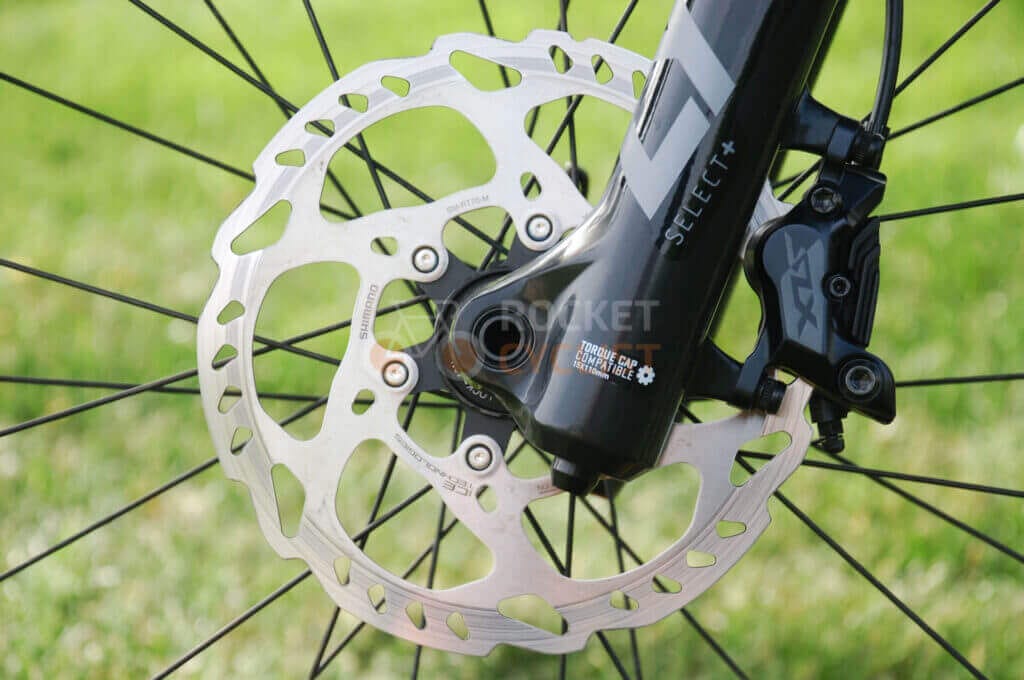
A Post Mount disc brake setup is a common type that you’ll find on several modern bicycles. The system has grown in popularity due to its relative ease of installation, adjustability, and minimalistic design.
Explanation of Post Mount System
The Post Mount disc brake setup is named so because the brake calipers attach directly to two posts on the bike’s fork or frame. The posts are typically parallel with the rotor (the disc in a disc brake system).
This design means the caliper can easily slide closer to or farther from the rotor, helping to adjust the brake alignment and to accommodate different rotor sizes.
Advantages and Disadvantages of Post Mount
Like any system, the Post Mount design comes with its own set of strengths and weaknesses.
Advantages:
- Easy adjustment: Post Mount brakes offer easy alignment over the rotor, cutting down on prep time when you’re itching to hit the trail or road.
- Simplicity: They use fewer adapters, resulting in a cleaner, more streamlined look.
- Variability: They can accommodate a variety of rotor sizes, providing flexibility for different riding styles and conditions.
Disadvantages:
- Durability: The lack of a sturdy adapter might make them more susceptible to damage under extreme conditions or when a hard strike occurs.
- Limitations on frame design: Because the brakes must mount directly to the frame, the design of certain bikes, particularly road bikes and aerodynamic models, may not accommodate a Post Mount system.
Every cyclist has different needs, and while the Post Mount brake system has its share of pros and cons, it’s ultimately up to you to determine whether it fits your style, preferences, and the demands of your ride.
IS Mount
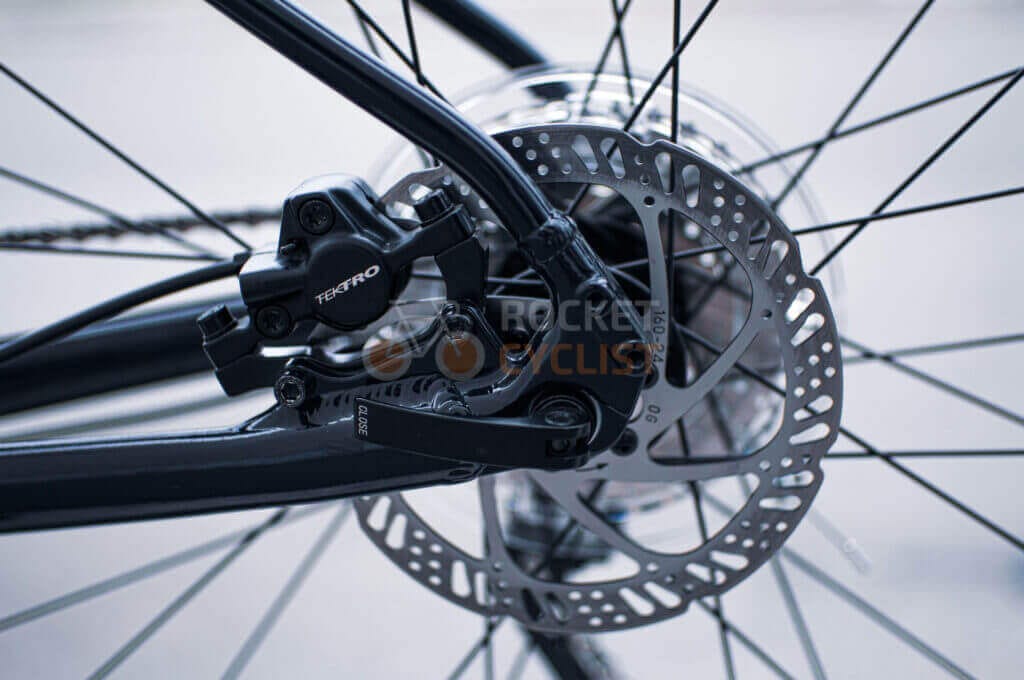
Explanation of IS mount system
The International Standard (IS mount) is one of the major types of disc brake mounts used in bicycles. Originally developed in the late 20th century, the IS mount consists of two drilled holes that are perpendicular to the plane of the wheel on the frame or fork where the brake caliper is attached.
Newer brake calipers often come with post mounts that don’t directly fit with the IS system. But adapters are widely available to convert post mount brakes to fit IS mount frames and forks.
Advantages and disadvantages of IS mount
The IS mount has its unique share of advantages and disadvantages when compared with other disc brake mount systems:
Advantages:
- Simplicity: The IS mount has a straightforward and simple design, making it easy to use and understand.
- Availability: Because of their longstanding history, IS mounts and corresponding adapters are readily available.
- Versatility: Diverse range of adapter options from IS to post mount brakes offer flexibility for different brake models.
Disadvantages:
- Setup complexity: Mounting brake calipers usually involves a certain degree of trial and error in the alignment process.
- Reduced heat management: IS mounts don’t dissipate heat as efficiently as the newer post mount or flat mount systems. This can theoretically lead to less consistent braking performance under demanding conditions.
Despite certain drawbacks, the IS mount continues to hold its ground in the cycling world due to its long-established history and simplicity.
Flat Mount
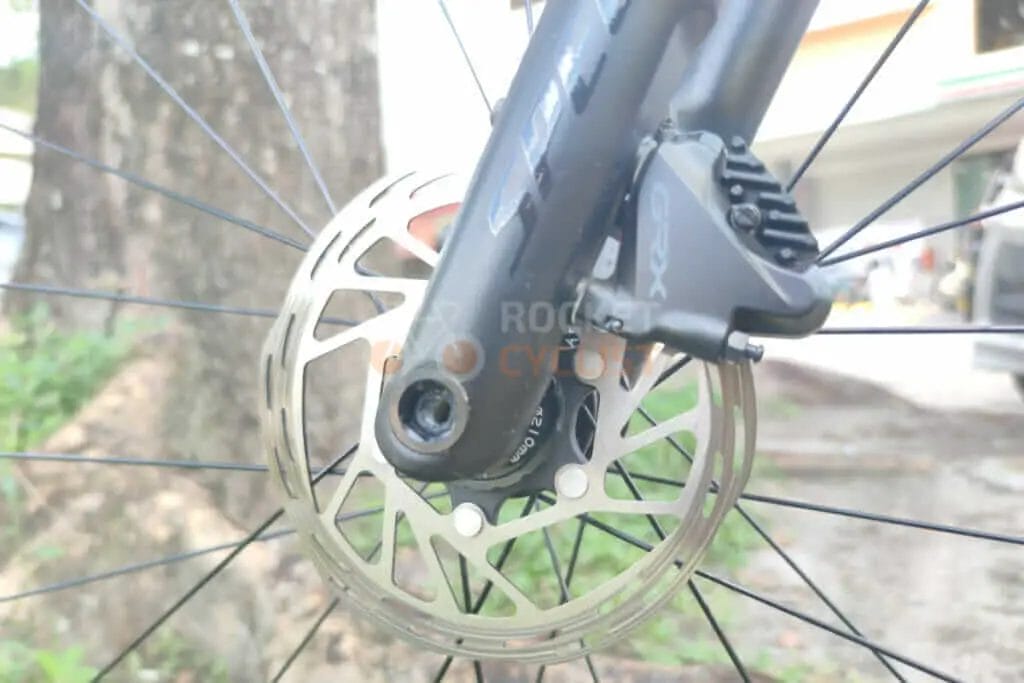
In the world of bicycles, disc brakes are a vital component for ensuring safety and control. One type of disc brake mounting system that has grown in popularity in recent times is the Flat Mount.
Explanation of Flat Mount System
The Flat Mount system is a recent innovation in the field of bicycle brake mounts. As the name entails, this system is flat in nature, providing a smooth and streamlined appearance. The calipers in this system are mounted with two bolts running through the bottom of the chainstay or fork, directly into the caliper.
This cleaner, integrated design was primarily developed by Shimano for road biking but has since been embraced by the bicycle industry at large.
Advantages and Disadvantages of Flat Mount
Like any technology, the Flat Mount system also comes with its set of benefits and downsides.
Advantages:
- Low Profile Design: The Flat Mount system has a low-profile design that blends well with the frame of the bike, providing a sleek, modern look.
- Weight: This system is lighter than the traditional post mount system, making it favorable for road bikes where weight is a key consideration.
- Compatibility: The Flat Mount system is compatible with all types of disc brakes, providing greater flexibility in terms of brake selection.
Disadvantages:
- Adaptability: Adapting a post mount caliper to a flat mount frame can be difficult, which might limit certain bike upgrade options.
- Mechanical complexity: Working with the Flat Mount system might be more complicated for unexperienced DIY mechanics.
In conclusion, the Flat Mount system offers several benefits including aesthetics, reduced weight, and compatibility, with a few downsides related to adaptability and mechanical complexity.
It is important to thoroughly research and consider these factors before opting for a bike with a Flat Mount brake system.
Direct Mount
The world of cycling offers a wide variety of bicycles tailored to suit different purposes and preferences. A crucial part of any good bicycle is the braking system, and for the best stopping power and modularity, disc brakes are a popular choice. One predominant disc brake mounting method used today is the “Direct Mount.”
Explanation of direct mount system
Direct Mount approach is a specific type of disc brake mount where the brake caliper mounts directly – without an adapter – to two holes drilled at a specific position on the fork or frame where the wheel’s hub sits. It’s designed to make brake installation and alignment easier and faster. The block distance for direct mount brakes is 20mm, which corresponds to the diameter of the rotor.
Advantages and disadvantages of direct mount
Like every system, the Direct Mount approach has its own set of pros and cons which cyclists need to consider based on their needs.
Advantages:
- Easy Installation: With no need for adapters, installation becomes quicker and easier, reducing the chances of improper setup.
- Adjustability: Disc brakes with direct mount provide greater adjustment freedom, making it easier to align the brake pads with the disc.
- Weight Reduction: Without the extra metal from adapters, the overall weight of the bicycle can be reduced, providing a slight performance enhancement.
Disadvantages:
- Compatibility Issues: Not all bike frames and forks are compatible with the direct mount system, limiting your options if you’re aiming for this setup.
- Fixed Size: The rotor size is typically fixed at 160mm for road bikes and 180mm for mountain bikes. If you need a different rotor size, an adapter will still be required.
Choosing whether or not to use the Direct Mount system on your bicycle largely depends on your cycling needs, the type of bicycle you have, and the circumstances under which you’ll be using it.
International Standard (IS) versus Post Mount (PM)
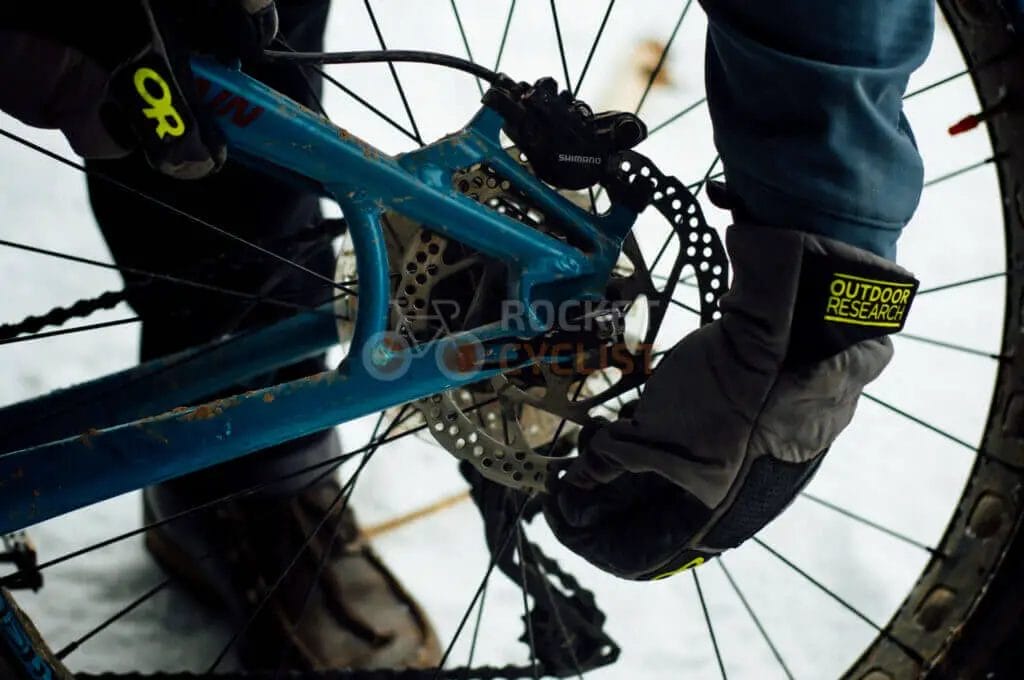
Disc brakes are an important feature on modern bicycles, offering superior stopping power and better performance in different weather conditions. When it comes to bicycle disc brake mounts, there are two primary standards: International Standard (IS) and Post Mount (PM).
Comparison between IS and PM mounts
International Standard (IS) Brake Mounts
The IS is an older brake mount design where the brake caliper is attached to the frame or fork with two bolts that are 51mm apart. With IS mounts, an adaptor is required to fit the brake rotor size and the caliper.
Key Features of IS mounts:
- Perfect for older bicycle models
- Requires an adapter for installation
- Ensures a secure fit
Post Mount (PM) Brake Mounts
The PM, meanwhile, is a newer design where the brake caliper is mounted directly onto the frame or fork, offering a more seamless look and simplified installation process. These mounts are becoming more standard on most new bicycles.
Key Features of PM mounts:
- Common in newer bicycle models
- Offers a more seamless design
- Simplifies the installation process
Here’s a brief comparison between IS and PM mounts:
| Category | IS mounts | PM mounts |
|---|---|---|
| Design | Older design with adapter | Newer, more seamless design |
| Use | Common in older bicycle models | Increasingly standard in newer models |
| Installation | More complicated, requires an adapter | More straightforward, without need for adapter |
While both IS and PM mounts serve the same function, their design, installation process, and use can differ significantly. Choosing between IS and PM will generally depend on your bicycle model and your personal preference.
Flat Mount versus Post Mount
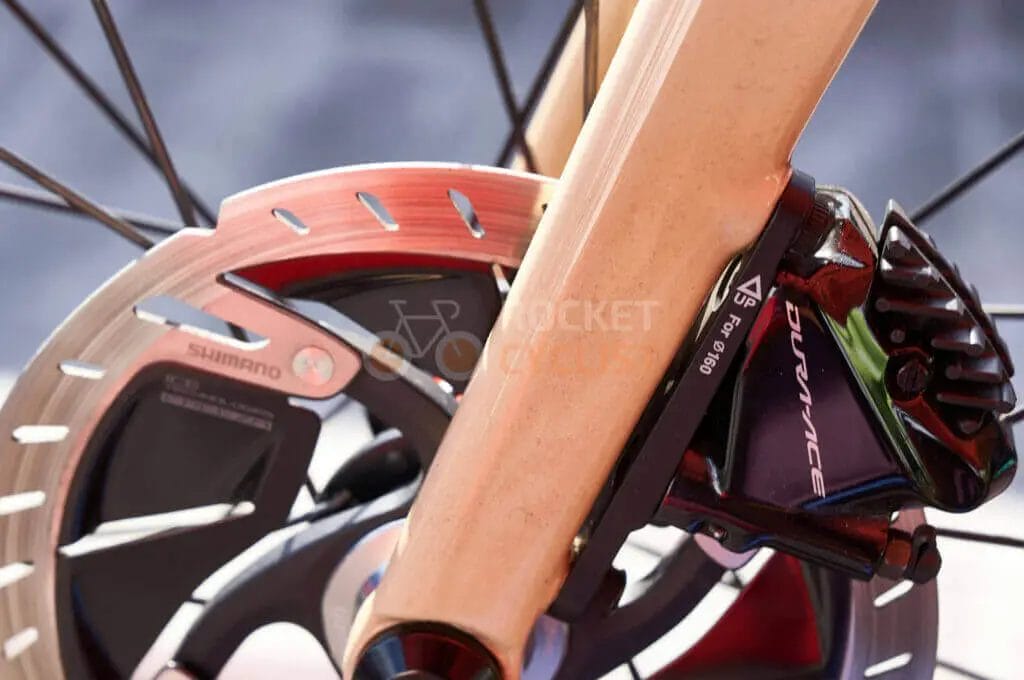
In the world of cycling, the disc brake system is increasingly replacing rim brakes, contributing to improved braking performance and therefore, safer rides. The key focus here is on understanding the two primary types of mounts for disc brakes: Flat Mount and Post Mount.
Comparison between flat mount and post mount
Flat Mount:
The flat mount is a newer, sleeker, and more low-profile style mounting system commonly found in road bikes nowadays. It’s renowned for its more streamlined and integrated look.
Key features:
- Streamlined design
- Often found in road and gravel bikes
- More aesthetically appealing
- Caliper aligned with the bike frame
Post Mount:
The post mount, on the other hand, is a standard on most mountain bikes, using two bolts which run perpendicular to the disc to attach the brake caliper to the frame or fork.
Key features:
- Perpendicular bolts
- Mostly found on mountain bikes
- Allows easy adjustments
- Caliper sits off the frame
Let’s look at these major differences in a side by side comparison:
| Features | Flat Mount | Post Mount |
|---|---|---|
| Design | Sleek and streamlined | More prominent |
| Aesthetics | More integrated | Sits off frame |
| Bolts | Run parallel to the disc | Run perpendicular to the disc |
| Commonly Found On | Typically road and gravel bikes | Usually mountain bikes |
| Adjustments | More complex due to tighter space | Allows easy adjustments |
Both mounting systems have their unique attributes, and choosing between them depends mostly on the type of cycling you wish to pursue. Mountain bikers typically prefer a post mount for peace of mind and easy adjustments.
Conversely, road cyclists are more drawn to the sleekness of the flat mount system. In conclusion, one is not clearly superior to the other; it all boils down to personal preference and cycling needs. Remember, safety should always be the primary consideration when choosing your disc brake system.
Choosing the Right Disc Brake Mount for Your Bike
When it comes to upgrading or replacing the disc brakes on your bike, the type of disc brake mount your bike uses is one of the most critical factors to consider. The task can seem a bit daunting if you don’t know the jargon, but fear not! This section will explain the basics to help you make a more informed choice.
Factors to consider when selecting disc brake mounts
Type of Disc Brake Mount: There are primarily three types of disc brake mounts – Post Mount, IS Mount (International Standard), and Flat Mount. Each type has distinct characteristics and uses.
Brake Caliper Compatibility: Not all brake calipers are compatible with all types of mounts, so you need to check if your choice of brake caliper is compatible with the disc brake mount you intend to use.
The Size of the Disc Brake Rotor: Each type of disc brake mount can accommodate a certain range of disc brake rotor sizes. You need to match the size of the rotor with the type of disc brake mount and make sure that they work together.
Compatibility with frame and fork
Frame Compatibility: If the mount isn’t compatible with the frame, you won’t be able to install it without potentially damaging the frame or the mount. Thus, you need to confirm that your bike’s frame or fork can accommodate the disc brake mount.
Fork Compatibility: Similar to frames, not all forks are compatible with all types of disc brake mounts. Check the specifications of your bike’s fork to confirm its compatibility with your chosen disc brake mount.
Now that you understand these critical factors, you’re in a better spot to choose the right disc brake mount for your bike. Recognize your requirements and choose wisely!
Other Types of Disc Brake Mounts
The world of disc brakes on bicycles has evolved significantly in recent years, providing cyclists with a range of options beyond the typical post and flat mounts. Additional options that have emerged include the lug mount and chainstay mount.
Overview of other types of disc brake mounts (e.g., lug mount, chainstay mount)
The Lug Mount: These mounts are becoming increasingly rare, but can still be found on some bicycles. They’re attached directly to the frame and fork via small protrusions or “lugs”, hence the name. Disc brake calipers are then bolted directly onto these lugs.
The Chainstay Mount: On certain other bicycle models, you might find the brake mounts located on the chainstay – the part of the frame that runs parallel to the chain. Chainstay mounts are a common feature on mountain bikes, where they help protect the rear brake from getting knocked and damaged.
Brief explanation of their uses and advantages
Lug Mount Advantages: Lug mounts tend to be easier to handle during maintenance or disc brake replacement as they do not require additional adapters. They can also accommodate larger rotors without the need for complex installations.
Chainstay Mount Advantages: Chainstay mounts, being located on the chainstay, keep the rear brake caliper out of the way of potential impact with rocks, branches, or other trail debris. This location can provide better protection for the brake in off-road conditions, and it often allows for cleaner routing of brake lines.
These other types of bicycle disc brake mounts, while not as common, still offer unique benefits to cycling enthusiasts in different riding conditions. The choice would ultimately depend on the cyclist’s specific needs and preferences.


